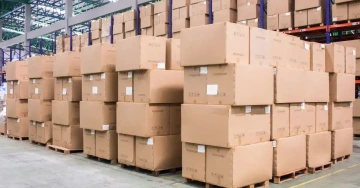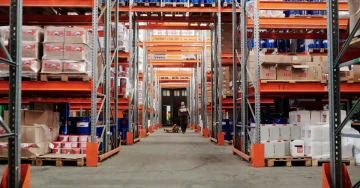E-shops Struggle with Service Prices
14. 9. 2022
E-shops are entering one of the most unpredictable seasons yet. A new survey conducted by Shipmall reveals how merchants view the challenges of 2022.

The upcoming holiday season is totally unpredictable for E-shops. No one knows how buyers will behave, whether to stock up in advance, or how high operating costs will go. There’s a real risk of product shortages or even e-shop bankruptcies if the situation is misjudged, says Renata Berková, Director of Operations and Projects at Shipmall, a company providing logistics outsourcing services for e-shops. Ahead of the holiday season, Shipmall conducted a survey involving over 10,000 e-shops.
How do you assess the year 2022 so far?
Based on our data, the course of 2022 mirrors last year’s trends. Our revenues are approximately 15% higher year-on-year. Considering the current economic climate, that’s a solid result. However, in previous years, we were growing at an average annual rate of about 30%.
What do you think is behind the slower revenue growth?
Discussions with clients and survey data both point to heightened nervousness among merchants. In the past, there was a stronger sense of predictability. But the events of recent years—and particularly 2022—have thrown us into a state of complete uncertainty. Merchants are now hesitant to make major decisions, such as switching to fulfillment. Moving to outsourced logistics means leaving behind existing systems, giving up current warehouse spaces, dissolving in-house warehouse teams, and adopting a new operational model. These are easier decisions when you're focused on growth and your existing warehouse no longer meets your capacity needs—when you're actively seeking a scalable solution for storage, packing, and shipping.
But wouldn’t a solution that can scale both up and down actually be very attractive right now?
That’s a good point. With our service, you only pay for the warehouse space you use and for the shipments that are packed and dispatched. So yes, it can be a viable solution even for those anticipating a drop in demand.
What did respondents say in your survey? What kind of Christmas season are e-shops expecting in 2022?
In a joint survey with our sister company Comgate, we asked e-shops how they view the development of 2022, what they expect from the holiday season, and specific areas like supply chain functionality and the rising costs of inputs and selling prices. Interestingly, 44% of merchants said they would stock up at a similar level as last year, 10% planned significantly less pre-stocking, and 38% weren’t planning to pre-stock at all. Only 8% plan to stock more than the previous year.
What do you make of that?
Many clients have expressed concern over households’ reduced spending ability on non-essential goods. It’s reasonable to expect that many households will cut back on holiday spending due to rising energy costs, mortgage payments, and general cost-of-living increases. On the other hand, we’ve seen in the past that merchants who underestimated the situation—like during COVID—ended up with not enough stock and missed out on sales during the key season.
What influences merchants’ decisions about pre-stocking for the season?
Previously, the key factor was estimating how much stock they could sell. Now, it’s far more complicated:
How much will household spending drop?
What’s the latest date to order stock to have it on time?
When and by how much will suppliers raise their prices?
How much will shipping cost by then?
What’s the optimal selling price for the product?
What will the cost of financing inventory be?
How will competitors behave?
As you can see, it’s a complex equation with many unknowns.
Do you expect a significant rise in product prices on e-shops?
Yes, price increases are likely. According to our survey, the top three reasons cited by e-shops for raising prices are:
Rising purchase prices from suppliers (83%)
Increased shipping costs (43%)
Rising energy prices (34%)
While the first two are fairly obvious, the third deserves some explanation. Energy costs are a major part of warehouse and logistics expenses. Warehouses need lighting, heating, and the equipment runs on electricity. In our Shipmall facilities in Prague, Týniště nad Orlicí, and Senec near Bratislava, we are currently paying about CZK 250,000 more per month for energy than we did a year ago.
How are you adapting to this new reality?
We’re constantly looking for ways to make our services more efficient. In the past, this meant gradual process optimization and digitalization. Now, we’re also focusing on consumables procurement and preparing for a holiday season where warehouse heating may become an issue.
We’ve moved to a permanent tendering process for consumables. Previously, we’d negotiate a price with suppliers (e.g., for packaging materials) and stick to it year-round. Now, packaging prices change every two weeks. For every purchase, we invite bids from a shortlist of verified suppliers and buy based on real-time offers. We've also centralized the purchase of packaging materials for all our Czech and Slovak warehouses, which makes sense when you’re spending millions of crowns annually.
We’re doing the same with other consumables. In parallel, we're addressing emergency warehouse heating. We're even considering building smaller, easier-to-heat packaging zones. We're exploring contingency plans for a variety of crisis scenarios.
What’s your long-term outlook?
Today’s highly unpredictable situation will stabilize eventually. I believe that the shift toward online shopping will continue. I’m also convinced of the strong future of fulfillment outsourcing services for e-shops. There's a lot of exciting work ahead.
About Renata Berková
Renata Berková has been with the Comgate Group since 2000, originally joining as a university student. Over the years, she has led complex projects for key clients. After a maternity leave, she returned to the logistics division—now Shipmall—where she serves as Director of Operations and Development Projects.








